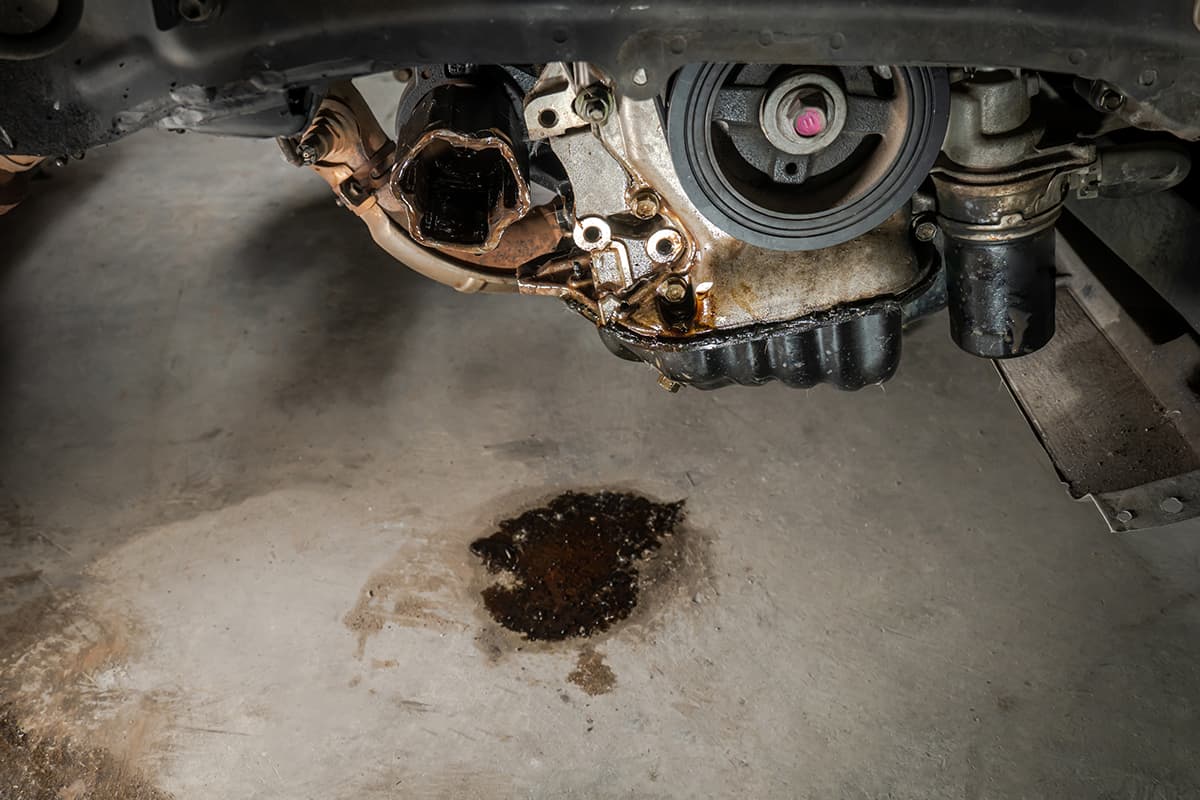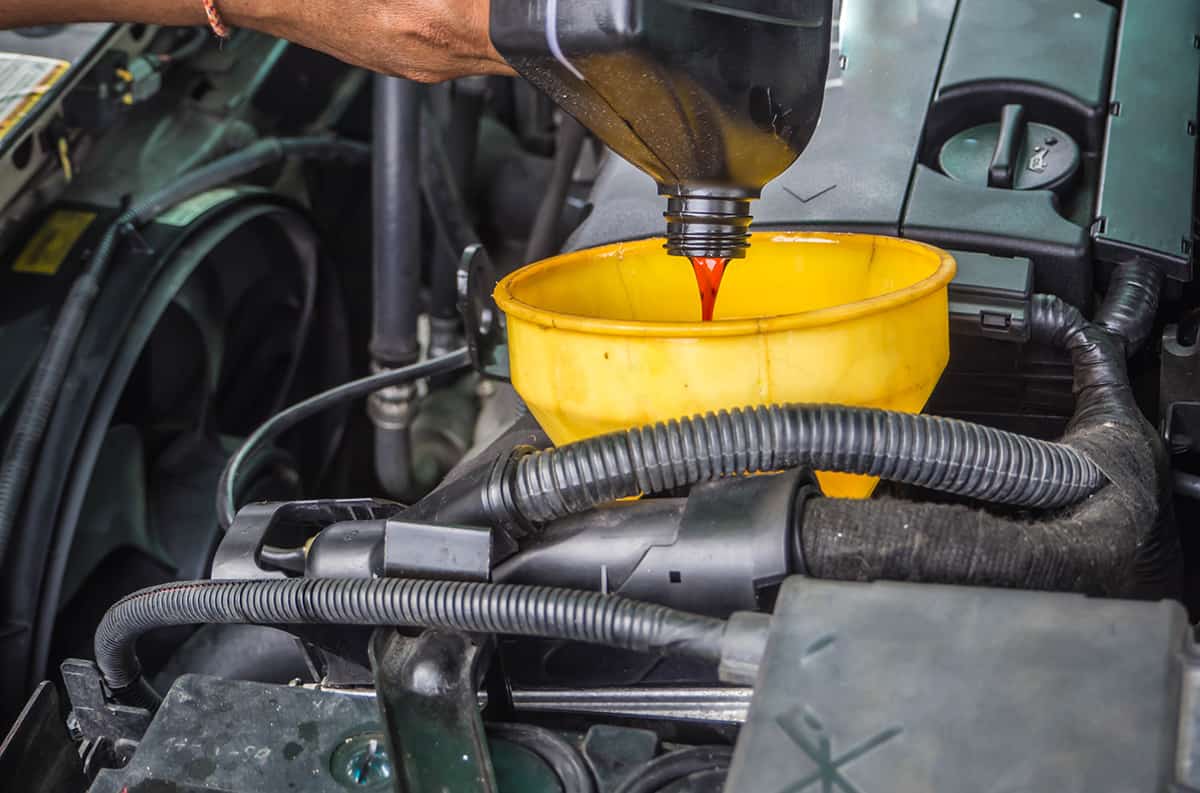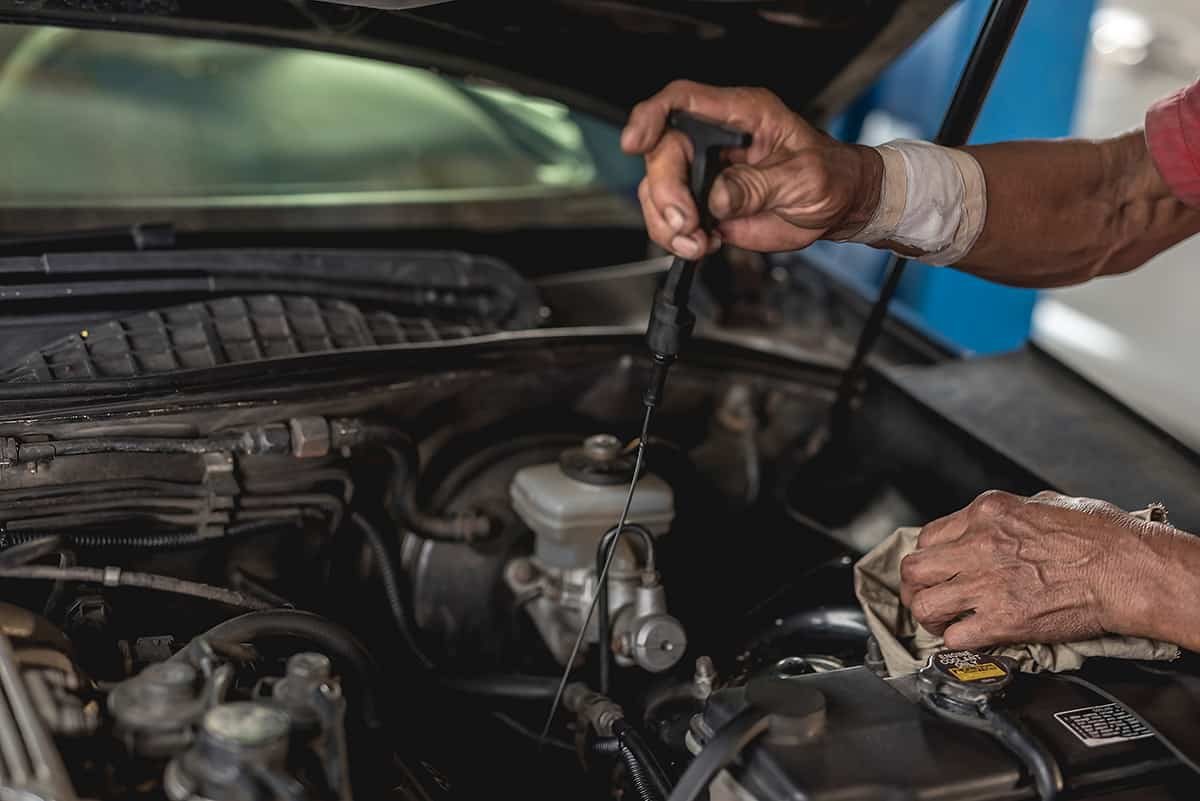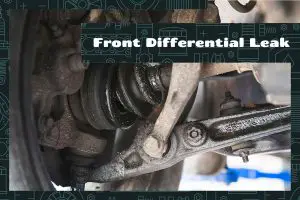Transmission keeps things running smoothly by lubricating the parts inside your transmission, which is a major component that controls how your car moves. If the fluid gets low, it can cause a lot of problems, kind of like how you’d feel sluggish if you didn’t drink enough water.
Keep an eye out for the following signs of low transmission fluid:
- Your car struggles or makes strange noises when changing gears.
- Your car shifts gear late or not at all.
- The warning light on your dashboard lights up.
- Your car feels overheated.
In this guide, we will dive deeper into the causes of low transmission fluid, its effects, and how to fix it.
Causes of Low Transmission Fluid
Transmission fluid is crucial for your car’s smooth operation. But sometimes, this fluid can get low, causing trouble. So, what causes low transmission fluid?
1. Fluid leaks

One common cause is a leak. Your car can lose transmission fluid if there’s a leak somewhere.
This can happen in the transmission itself or in the lines carrying the fluid. You might notice a reddish fluid on your garage floor or driveway. If you see this, it’s a sign of a leak, and you should get it checked out.
2. Inadequate maintenance
Your car’s transmission fluid needs to be refilled or replaced periodically. If this isn’t done regularly, the fluid can get low. Regular maintenance also involves checking for leaks and fixing any issues promptly.
3. Faulty transmission components
Faulty transmission components can also lead to low fluid. The transmission is made up of many parts, and if any of them aren’t working right, it can cause a leak or make the fluid burn off faster. This includes things like seals, gaskets, and the transmission pan.
4. Manufacturer defects
Lastly, there could be manufacturer defects. This means something was wrong with the car when it was made. If the transmission isn’t sealed properly or if there’s a problem with the parts, this can cause low transmission fluid. This isn’t very common, but it does happen.
Signs of Low Transmission Fluid
Here’s how you can tell if your car has low transmission fluid.
1. Slipping gears

When your car changes gears, it should be smooth and almost unnoticeable. But if your transmission fluid is low, the transmission might slip, whether it’s still heating up or otherwise. This means your car might suddenly change gears for no reason or not stay in the gear you select.
2. Delayed shifts
Next, your car might have delayed shifts. This is when there’s a noticeable delay before your car changes gears. If you’re driving an automatic, you might notice this when you’re speeding up or slowing down.
3. Unusual noises
Low transmission fluid can also cause your car to make unusual noises. This can be a whining or humming noise coming from the transmission. If you hear such noises, it’s best to get your car checked out.
4. Transmission overheating
Your car’s temperature gauge might show that it’s getting too hot, especially when you’re driving hard or towing something. Overheating can damage the transmission and burn off the fluid.
5. Warning lights
The last sign is the warning lights on your dashboard. Your car’s computer monitors the transmission and other systems. If it detects low transmission fluid, it might turn on a warning light. This could be the check engine light or a specific transmission warning light.
Effects of Low Transmission Fluid
Here’s what will typically happen when you don’t replace or refill your transmission fluid on time.
1. Poor transmission performance
The transmission controls how your car moves. When the fluid is low, it can’t do its job properly. This can cause issues like gear slipping or delayed shifts. This means your car might not respond right away when you’re trying to speed up or slow down.
2. Increased wear and tear
The fluid acts as a protective layer for the parts inside the transmission. When there’s not enough fluid, the parts can rub against each other. Over time, this can wear down the parts and cause them to break.
3. Damaged transmission components

The fluid helps cool the parts and prevent overheating. If the fluid is low, the transmission can get too hot. This heat can warp or damage the parts. Over time, this can cause serious damage that might need expensive repairs.
4. Reduced fuel efficiency
The transmission plays a big role in how efficiently your car uses fuel. When the fluid is low, the transmission has to work harder. This can make your car use more fuel. So if you notice you’re filling up the gas tank more often, it might be due to low transmission fluid.
5. Complete transmission failure
If the fluid gets too low and the issue isn’t fixed, it can cause the transmission to fail. This means your car won’t be able to move. Fixing or replacing a failed transmission can be very costly.
Fixes for Low Transmission Fluid
If you notice any of the aforementioned signs or effects, it might be time to fix the root cause—i.e., low transmission fluid. Here’s how it’s done.
1. Checking and adding fluid

The first thing you should do is check the fluid level. Here’s how:
- Start your car and let it warm up for a few minutes.
- Locate the transmission fluid dipstick (check your car’s manual if you’re not sure where it is).
- Pull out the dipstick, wipe it clean, then reinsert it.
- Pull it out again and look at the fluid level. If it’s below the “Full” mark, you need to add fluid.
To add fluid:
- Find the transmission fluid filler tube (again, check your manual if you’re not sure).
- Using a funnel, slowly pour in the correct type of transmission fluid until it reaches the “Full” mark on the dipstick.
- Make sure to check the level again after driving your car for a bit to ensure it’s still at the right level.
2. Fixing leaks
If you find that your car is leaking transmission fluid, you’ll need to fix the leak. This usually involves replacing the part that’s leaking. Here’s a general idea of how it’s done:
- Determine where the leak is coming from. This could be the transmission itself or the lines that carry the fluid.
- Once you’ve identified the leaking part, it’ll need to be replaced. This usually requires removing the old part and installing a new one.
- After the new part is installed, the fluid level should be checked and adjusted as necessary.
3. Preventing overheating
Preventing your car from overheating can help maintain the transmission fluid level. Here’s how to prevent overheating:
- Avoid driving hard or towing heavy loads, especially in hot weather.
- Regularly check your car’s temperature gauge while driving. If it’s showing a high temperature, pull over and let your car cool down.
- Have your car serviced regularly. This can help identify and fix issues that might cause overheating.
4. Regular maintenance
Regular maintenance is key to preventing low transmission fluid. This includes regular fluid checks and changes, as well as checking for leaks. Here’s a basic maintenance schedule:
- Check your transmission fluid level every month.
- Have your transmission fluid changed as recommended by your car’s manufacturer (usually every 30,000 to 100,000 miles).
- Regularly inspect your car for leaks. If you see any red fluid on the ground under your car, it might be a transmission fluid leak.
FAQs
1. How often should I check my transmission fluid?
Check your transmission fluid every month. It’s easy! Just pull out the dipstick, wipe it, dip it back in, pull it out again, and see if the fluid is up to the “Full” mark.
2. What type of transmission fluid should I use?
Your car’s manual tells you what type of transmission fluid to use. Make sure you use the right one because different cars need different fluids.
3. Can I drive with low transmission fluid?
Operating a vehicle with low transmission fluid levels poses significant risks to both the vehicle and its occupants. Inadequate fluid can lead to severe damage to the car’s transmission system, a critical component essential for the proper functioning of the vehicle.
Insufficient fluid levels can cause increased friction and heat within the transmission, resulting in accelerated wear and tear, potential gear slippage, and, ultimately, transmission failure. When the transmission fails, the car loses its ability to move, leaving drivers stranded and requiring costly repairs.
Generally, you can drive up to 15 miles on a low transmission fluid level without harming your transmission. But add more fluid soon and avoid heavy acceleration or high speeds.
4. How long does it take to fix a transmission fluid leak?
The time required to address a transmission fluid leak typically ranges from 1 to 4 hours, although the duration can vary based on the underlying cause of the leakage. Mechanics carefully diagnose the issue to determine the extent of the problem and the necessary steps for fixing it. Factors such as the location of the leak, the type of transmission system, and the availability of replacement parts can influence the duration of the repair.
5. When should I change my transmission fluid??
Changing your transmission fluid depends on your car’s make and model. Some need a change every 30,000 miles, others every 100,000 miles. But a good rule is to change it every 45,000 to 60,000 miles. Always check your car’s manual for specific guidance.






